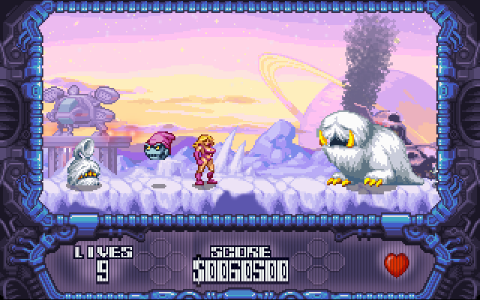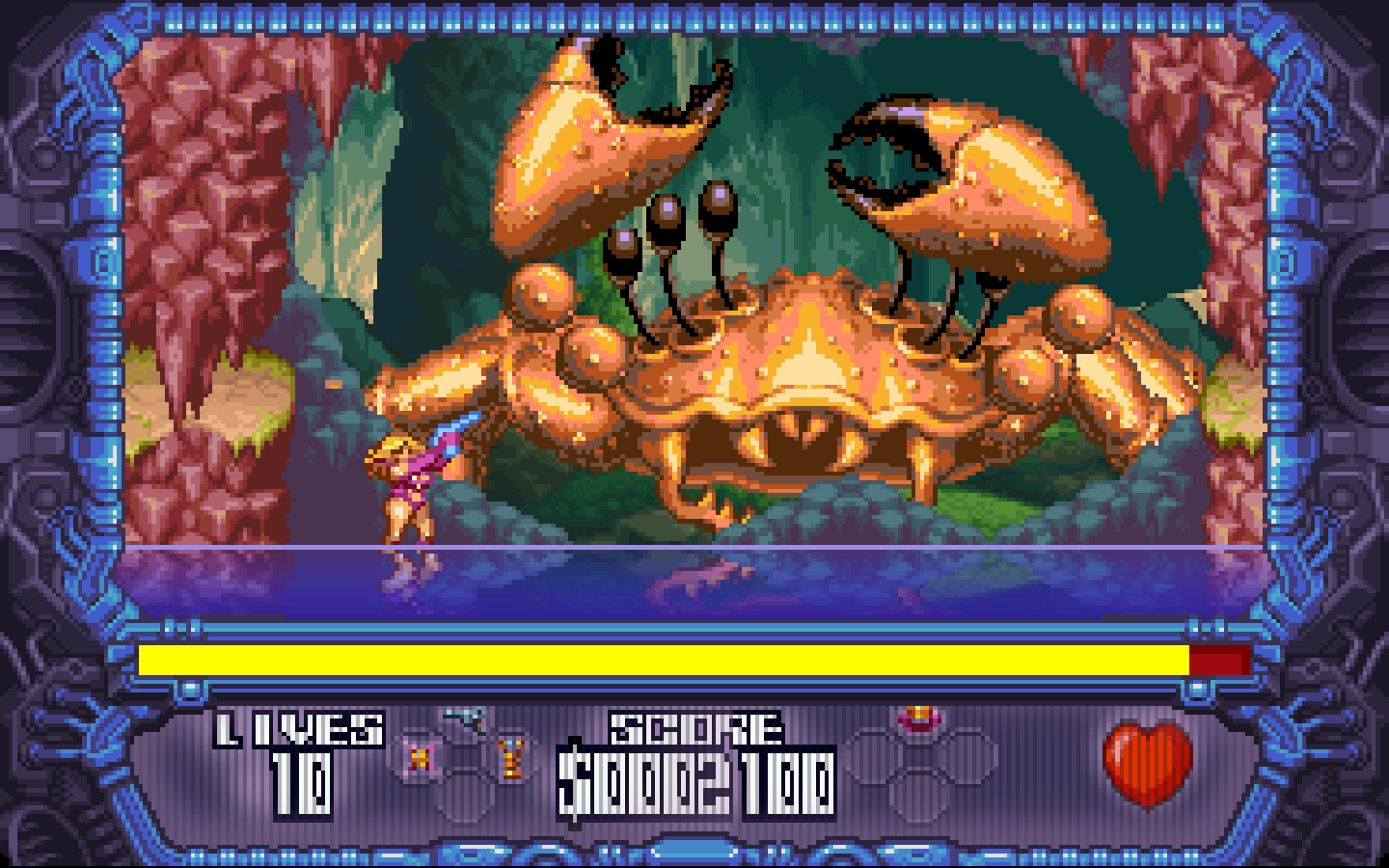
The game’s soundtrack is also really cool. Jake Kaufman, who is probably best known for his work with Way Forward games, shows up here with some chip tunes that encompass the action, and look. They require you to memorize their patterns of movement, while trying to avoid any projectiles they throw at you. It really makes for some memorable experiences, and joyfully stressful moments. All of the game’s bosses take a very old school approach. Each of them taking up an entire chamber, or a quarter of the real estate of the screen. There is also the fact that Spacebook is blatantly running on a ZX Spectrum in the intro, and all of the wonderful art looks like it could have been done on a Commodore Amiga. There are also some Commodore 64 BASIC characters seen in the scoreboard when the second level begins. The game itself runs in a centered window the way many Commodore 64 games did, with the bottom of the screen used as a HUD. Ultionus’ sprite, and background art is a love letter to 8-bit, and 16-bit computers of the late 1980’s. There are entirely new segments, boss fights are here, and the art in the game is spectacular. Ultionus isn’t a very long game, and it isn’t a cut, and paste clone of Phantis either. Overall, there are seven stages called zones, each one progressively upping up the ante. Most of the game is made up of these stages. The coins are hidden in the platform stages along with the storefronts themselves. The shops aren’t always easy to get to, and they require a secret coin to enter. But don’t think it will be a simple matter to grind points, and enter the shops. You’ll add other abilities to the laser pistol, as well as the armor by buying these. There are actually four weapon slots, and four armor upgrades, along with a super secret upgrade. You’ll have to explore areas to find not only the hidden stores, but even general weapons, like super jump, and a laser pistol. Doing well in the initial stage can help you be able to buy at least one of the upgrades for your character.Įventually you’ll find your way to the second stage, which again, is awfully similar to Phantis. Getting a high score is definitely something to shoot for because there are hidden shops later in the game that offer you power ups for points. Asteroids are actually worth more points, and it’s also worth mentioning the scoring system. Taking down waves, and waves of enemy ships, and asteroids. You’ll pilot a ship through the reaches of space in an R-Type styled shmup. The game begins almost exactly the way Phantis does. Serena then jets off on a mission to put the prince in his place. She goes up on Spacebook using ZX Spectrum to discuss it when the Space Prince replies with an insult.

The game opens up with a cut scene depicting Serena S (a play on the Game Over II character name) in her ship after having saved the universe again. Ultionus: A Tale Of Petty Revenge is one part homage to Phantis, and one part parody. Plays homage really well.ĬONS: May play homage a little too well for some.Ī_RIVAL: Sends things off with a wonderful single. What does this have to do with today’s game? A lot actually. Over the years both Game Over, and Game Over II would become cult classics. The re-branded sequel, swapped the characters, and renamed Major Locke to Commander Serena who appears to have been influenced by the Taarna character in Heavy Metal. The game put you in a role of woman named Major Locke who has to rescue her boyfriend Arkon from the planet Phantis.

It was better enough that outside of Spain, the game was officially published as Game Over II. It wasn’t a particularly remarkable game, but it was better than one of Dinamic’s earlier games, Game Over, which was a flip-screen adventure game.

A game that melded Gradius style space shooting with flip-screen adventure gaming popularized by the Nodes Of Yesod. One of their noteworthy games in the European market was a game called Phantis. Based in Spain, the company put out a number of titles across several platforms. Vying to make original games in these genres. This gave birth to a wealth of independent developers, and major publishers on computer platforms. Many of the best arcade games saw ports not only on systems like the Nintendo Entertainment System, and Sega Master system, but the Commodore 64, Atari 8-bit family, and the ZX Spectrum too. Arcade shmups, and action platformers were also very popular. Every genre continued to grow on home computers. As Nintendo was slowly capturing, and rebuilding the console market in the states, computers continued to hold their own. Back in 1987 Home Computer gaming was bustling.


 0 kommentar(er)
0 kommentar(er)
